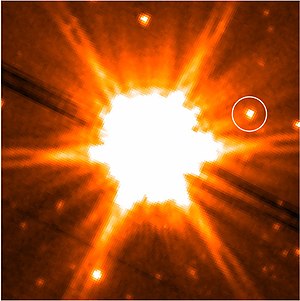54 Piscium
|
Star 54 Piscium |
|||||||||||||||||
|---|---|---|---|---|---|---|---|---|---|---|---|---|---|---|---|---|---|

|
|||||||||||||||||
| Infrared image from 54 Psc ( Spitzer Space Telescope ); circled: the brown dwarf 54 Psc B | |||||||||||||||||
| AladinLite | |||||||||||||||||
|
Observation dates equinox : J2000.0 , epoch : J2000.0 |
|||||||||||||||||
| Constellation | fishes | ||||||||||||||||
| Right ascension | 00 h 39 m 21.8 s | ||||||||||||||||
| declination | + 21 ° 15 ′ 2 ″ | ||||||||||||||||
| Apparent brightness | 5.80 likes | ||||||||||||||||
| Typing | |||||||||||||||||
| Known exoplanets | 1 | ||||||||||||||||
| B − V color index | +0.85 | ||||||||||||||||
| U − B color index | +0.57 | ||||||||||||||||
| R − I index | +0.39 | ||||||||||||||||
| Spectral class | K0 V | ||||||||||||||||
| Astrometry | |||||||||||||||||
| Radial velocity | (−34 ± 2) km / s | ||||||||||||||||
| parallax | (90.03 ± 0.72) mas | ||||||||||||||||
| distance | (36.23 ± 0.29) ly (11.11 ± 0.09) pc |
||||||||||||||||
| Proper movement | |||||||||||||||||
| Rec. Share: | (−461.32 ± 0.33) mas / a | ||||||||||||||||
| Dec. portion: | (−370.02 ± 0.28) mas / a | ||||||||||||||||
| Physical Properties | |||||||||||||||||
| Dimensions | approx. 0.8 M ☉ | ||||||||||||||||
| radius | (0.95 ± 0.03) R ☉ | ||||||||||||||||
| Effective temperature | approx. 5200 K | ||||||||||||||||
| Metallicity [Fe / H] | approx. +0.05 (approx. 110% of the sun) |
||||||||||||||||
| Rotation time | 44.5 d | ||||||||||||||||
|
Other names and catalog entries |
|||||||||||||||||
|
|||||||||||||||||
54 Piscium ( 54 Psc for short ), also known as HD 3651 , is a planetary system in the Pisces constellation . The central body is a main sequence star of apparent magnitude 5.9 and spectral class K0. The distance of 54 Piscium to Earth is only 36 light years and under good conditions the star can be seen with the naked eye.
The central star, called 54 Piscium A to distinguish it from the other bodies in the system, often (and before the discovery of the accompanying objects) but also simply 54 Piscium, is surrounded by two substellar companions, which are usually identified by the catalog name of the system in HD Catalog is used. The central star is accompanied by an exoplanet , HD 3651 b, at a relatively short distance , and by a brown dwarf , HD 3651 B, at a greater distance .
Central star
54 Piscium A (HD 3651 A) has about 80 percent of the mass of our sun and is somewhat less bright than this. Its metallicity is about 110 percent that of the sun (based on iron). An activity cycle of around 13 years was also observed in the star. This suggests that the main component of the system is magnetically active. Intensive observations and measurements of emission strengths suggest that 54 Piscium A is one of the best contenders for an imminent activity minimum (see Maunder minimum ).
Brown dwarf
HD 3651 B ( 54 Piscium B ) is a methane dwarf of the spectral class T7 to T8. The angular distance to the central star is 43 ", which when projected corresponds to a distance of about 480 AU. It takes over 1000 years for one orbit and has at least 50 times the mass of Jupiter. 54 Piscium B was measured independently of one another with the help of the Spitzer space telescope (Luhman et al. 2007) as well as with the help of ground-based telescopes (Murgauer et al. 2006).
Exoplanet
HD 3651 b ( 54 Piscium b , formally and also HD 3651 Ab to avoid confusion ) is an exoplanet with a minimum mass of approx. 0.23 Jupiter masses and a sidereal orbital period of 62.206 days, which forms the central star of the system at a distance of approx 0.30 astronomical units orbited with an eccentricity of 0.6. It was published in 2003 by Paul Butler et al. Discovered in 2003 using the radial velocity method.
Web links
- SIMBAD entry for 54 Psc A
- 54 Psc at Extrasolar Visions ( Memento from July 16, 2012 in the Internet Archive ) star entry ( Memento from June 5, 2011 in the Internet Archive )
- 54 Psc at the Extrasolar Planets Encyclopaedia ( Memento from August 12, 2011 in the Internet Archive )
- 54 Piscium at SolStation
- Scientists Snap Images of First Brown Dwarf in Planetary System ( Memento from May 25, 2009 on the Internet Archive ) (message on Penn State website in English)
Individual evidence
- ↑ a b c d Hipparcos catalog
- ↑ a b c SIMBAD database
- ↑ a b c Bright Star Catalog
- ↑ SPACE.com - Distorted Solar System Discovered
- ↑ The Exoplanet in the "Encyclopedia of Extrasolar Planets" (English)